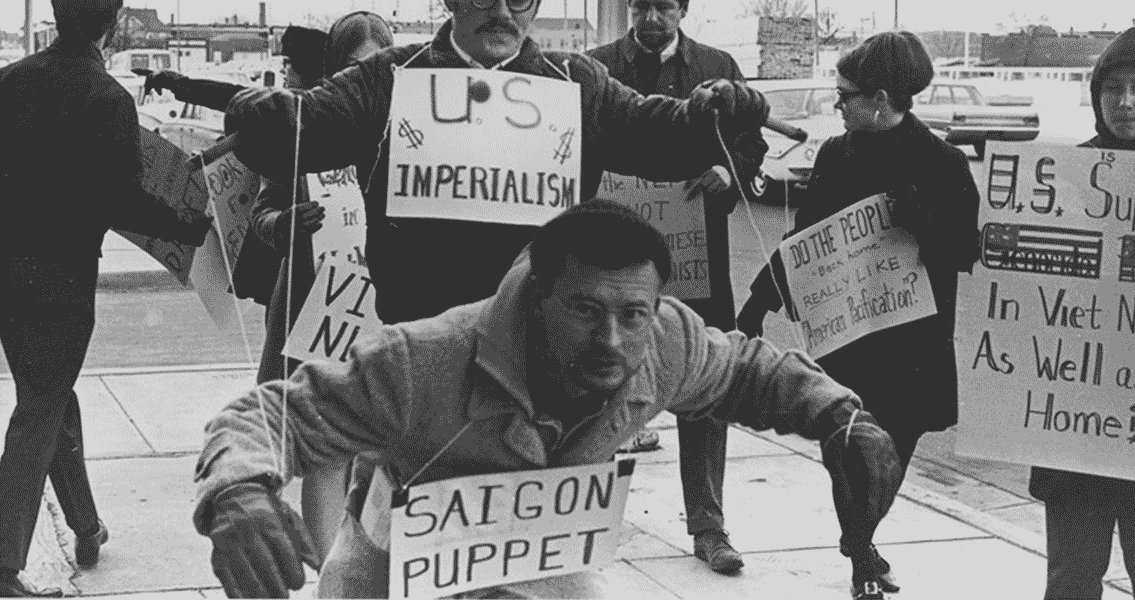<![CDATA[On the 21st October 1967, thousands of protestors marched on the Pentagon in Washington DC in one of the largest protests against the Vietnam War. The protest came to symbolise the ever declining support for President Lyndon B. Johnson and the presence of US soldiers in Vietnam. The massive demonstration also stands as a major example of the powerful spirit of activism and dissent that is so often associated with the 1960's. The protest started when nearly 100,000 people gathered in the American capital to lend their voice to the peace movement. The day's actions opened with a largely peaceful rally at the Lincoln Memorial. After the rally however, more than 50,000 people marched on the Pentagon, to demand an end to the conflict. Many of the protestors carried the red, blue and gold flag of the Viet Cong. Inevitably provisions had been put in place to protect the vital centre of the American government and military. Between five and six thousand armed US soldiers were stationed inside the Pentagon and other government buildings, in anticipation of the march. On top of this was a substantial police and US marshal force. The more radical element of the protestors, who were positioned at the front of the march, attempted to storm the Pentagon. The most serious incident occurred at around 6:00pm, when between twenty and thirty protestors managed to storm their way into the government building. As the police and soldiers moved to counter the aggressive part of the demonstration, a full scale riot erupted. Protestors would continue to surround the Pentagon and attempt to force entry until the early hours of the following morning. By the end of the protest, 683 people had been arrested, including US novelist Norman Mailer and two United Press International reporters. The work of the government's forces was complicated by the continue obstinance of the protestors, even after they had been arrested. Frequently the protestors immediately collapsed when captured by police or marshals, meaning they had to be dragged through the crowd of protestors who attempted to break them free. The intense nature and longevity of the protest meant that the authorities became increasingly heavy handed, as they begun to feel the effects of exhaustion. A total of forty seven Marshals, police and demonstrators were injured by the end of the protest. The Washington Protest represented the ever increasing anger at the United States' role in the Vietnam War. Opinion polls in the summer of 1967 had revealed that support for the war had fallen to below 50% for the first time. To make matters worse, the Johnson administration had recently announced its intention to request a 10% increase in taxes to help pay for the war. Solidarity demonstrations were held elsewhere in the US, and abroad. The most violent occurred in London, after 3000 people attempted to storm the US embassy. In response to the protests, the US government launched a massive propaganda campaign in an attempt to rekindle support for the war. The government was becoming concerned that the protest in Washington reflected dissatisfaction at the US administration's Cold War policies in general, and not just its actions in Vietnam. The march and riot in Washington are important as they revealed the growing agitation that was forming against the Vietnam War, and the increasing bravery US citizens had to publicly voice their discontent. Support for the war would continue to plummet after the events in Washington. Controversies such as the brutal humiliation of the Tet offensive and the tragedy at the Kent State University protest further tarnished the reputation of the US government. By the time the US withdrew from Vietnam, it had failed to achieve a military victory, and perhaps even more significant for the long term, it had lost the public relations war as well. ]]>
The Washington Protest 1967
